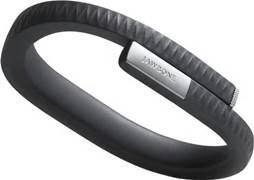Finding a Fit with Wearable Devices
Can you train like an Olympic athlete, see through the back of your head, and remember everything you did today? These things are completely unrealistic for most of us, but we are getting closer with breakthroughs in wearable devices.
 Personal fitness monitors such as the Fitbit Force, the Jawbone, and Fuel are consumer gadgets that fit like bracelets and serve as personal coaches – tracking your fitness activity, sleep, and calorie burn rate. Fitness fanatics now log their meals onto their cell phones and get nutritional guidance for building muscle mass, losing weight, or just feeling better.
Personal fitness monitors such as the Fitbit Force, the Jawbone, and Fuel are consumer gadgets that fit like bracelets and serve as personal coaches – tracking your fitness activity, sleep, and calorie burn rate. Fitness fanatics now log their meals onto their cell phones and get nutritional guidance for building muscle mass, losing weight, or just feeling better.
Publicly-traded companies, including Nike (ticker: NKE) and Garmin (GRMN), are some of the early entrants into the fitness monitor trend. They’ve “broken the code” to making wearable sensors fashionable by marketing them to athletes.
But we are seeing other variations, too. Google Glass (GOOG) wraps around the face to take photographs and provide voice-activated internet access. Taser (TASR) is testing a similar device with police departments to record interactions with suspected lawbreakers. Motorola Solutions (MOT) is working on a wearable headset for surgeons and mechanics who need to keep their hands free.
Meanwhile, the NFC Ring (available later this year) has a near-field communications chip designed to identify the wearer at close distances. This can be used for tasks such unlocking doors and making touchless payments using networks that already exist in the U.K. and Europe.
Want cool? A personal favorite is a motorcycle helmet being made by Skully which features an integrated GPS map on the visor, a rear-view camera, stereo system, and hands-free cellphone interface. All of this is powered by voice commands through an Android-based operating system.
Here are few possibilities on where the wearable device trend is going…
- The most popular wearable devices may be almost invisible – like hearing aids or contact lenses. MC-10 is an early pioneer in creating wearable, washable circuitry that is flexible and conforms to the skin. One of their designs can be stamped onto user and sealed with a sprayable bandage. (This company bears watching.)
- While athletes are the early adopters, a bigger market might be wearable health devices to monitor glucose levels, hydration, and body temperature for the elderly.
- The future of shopping may resemble shoplifting. Sales clerks may be only needed for those who don’t have wearable personal identification devices. (Further advances in biometrics may provide a universal alternative).
- Eventually, wearable devices may be powered by the body’s own energy – physical movement, heat, electricity, blood sugars, or capillary action. Some may be powered by radio waves or sunlight.
The shift toward wearable devices is very much linked to another trend that we’ve covered in the past – The Internet of Things. These both fall in the category of “too big to be avoidable”, but it is too early to say which organizations will benefit the most. The technological ecosystem is far too big and complicated for that. Furthermore, some of the most popular applications will be designed by companies that are not open to public investment. For the purpose of identifying possible opportunities, it might be useful to think about what these devices have in common…
- Wireless Communication. Existing technologies include Bluetooth and RFID chips. Look to Broadcom (BRCM), Qualcomm (QCOM), Texas Instruments (TXN), and Atmel (ATML). NXP Semiconductors (NXPI) is known for its work in near field communications and has a strong patent portfolio.
- Motion Sensors/Accelerometers. InvenSense (INVN) is a “pure play” here.
- Displays. OLEDs are perfect for wearable devices – it is the only display technology that is thin, energy efficient, flexible, and/or fully transparent. Universal Display Systems (OLED) and Samsung are the heavyweights.
Not only can we feel the excitement, but we can measure it, see it on our cellphones, and post it on Twitter, too.
(Disclosure: Information contained herein is for educational purposes only and is not to be considered a recommendation to buy or sell any security or investment advice. Mr. Lee is the Founder of Strategic Foresight Investments, a registered investment advisor, and holds shares of Google, Universal Display Systems, and Qualcomm, in client accounts as of February 13, 2014)
